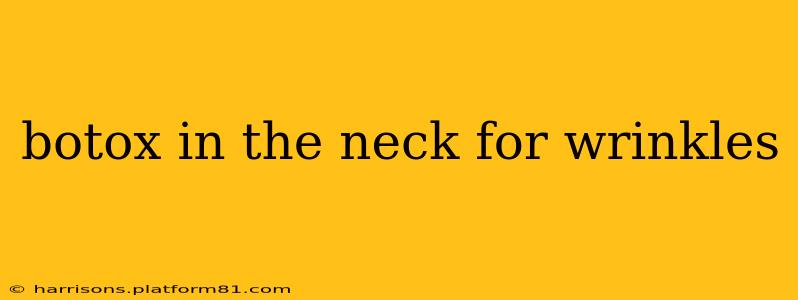Neck wrinkles, often referred to as "tech neck" or "turkey neck," are a common concern as we age. While genetics and sun exposure play a role, the constant downward pull of gravity and repetitive movements like looking at our phones contribute significantly. Fortunately, Botox offers a non-surgical solution to address these concerns. This guide explores everything you need to know about Botox neck treatments, addressing common questions and concerns.
What is Botox and How Does it Work?
Botox, short for botulinum toxin type A, is a purified protein that temporarily relaxes the muscles responsible for wrinkles. When injected into the neck muscles (platysma bands), it weakens their contraction, smoothing out the vertical bands and improving the overall appearance of the neck's skin. It doesn't fill wrinkles but rather prevents the muscles from creating them in the first place. The effects are temporary, typically lasting 3-4 months, requiring repeat treatments to maintain results.
What are the Benefits of Botox for Neck Wrinkles?
- Reduced Appearance of Vertical Neck Bands: Botox effectively softens and minimizes the prominent vertical bands that often appear on the neck with age.
- Improved Neck Contour: By relaxing the platysma muscles, Botox can subtly lift and improve the overall contour of the neck.
- Non-Surgical and Minimally Invasive: Unlike surgical neck lifts, Botox treatment is a quick, outpatient procedure with minimal downtime.
- Natural-Looking Results: When administered by a skilled professional, Botox produces natural-looking results, avoiding an overly "frozen" or unnatural appearance.
- Relatively Quick Procedure: Treatment typically takes only 15-20 minutes.
How Long Does Botox in the Neck Last?
The effects of Botox in the neck typically last for 3-4 months. Individual results may vary depending on factors such as metabolism, muscle strength, and the amount of Botox injected. As the effects wear off gradually, you'll notice a slow return to the previous appearance of neck wrinkles. Repeat treatments are necessary to maintain the desired results.
What is the Recovery Time After Botox Neck Treatment?
Botox neck injections are minimally invasive and require very little downtime. You can typically return to your normal activities immediately after the procedure. However, it's recommended to avoid strenuous activities and excessive sun exposure for at least 24 hours. Some patients may experience mild bruising or swelling at the injection sites, which usually resolves within a few days.
Does Botox in the Neck Hurt?
Most patients describe the discomfort of Botox injections as minimal. A numbing cream can be applied before the injections to further reduce any discomfort. The injection process itself is relatively quick, and any discomfort is usually fleeting.
What are the Potential Side Effects of Botox for Neck Wrinkles?
While generally safe, Botox injections can have some potential side effects, although they are rare. These can include:
- Mild bruising or swelling: This typically resolves within a few days.
- Temporary muscle weakness: This is usually mild and temporary.
- Headache: This is a relatively common side effect.
- Neck pain: Less common, but possible.
It's crucial to choose a qualified and experienced injector to minimize the risk of side effects. Always discuss any concerns or medical history with your practitioner before undergoing the treatment.
How Much Does Botox for Neck Wrinkles Cost?
The cost of Botox neck treatments varies depending on factors like the amount of Botox needed, the location of the clinic, and the injector's experience. It's best to contact several clinics in your area to get a price quote and compare options.
Is Botox in the Neck Right for Me?
Botox neck treatment is suitable for individuals who want to reduce the appearance of vertical neck bands and improve their neck's overall contour. However, it's crucial to consult with a qualified dermatologist or plastic surgeon to determine if this procedure is the right option for you based on your specific needs and medical history. They can assess your skin and muscle condition and recommend the most appropriate treatment plan. A thorough consultation helps ensure realistic expectations and safe, effective treatment.
